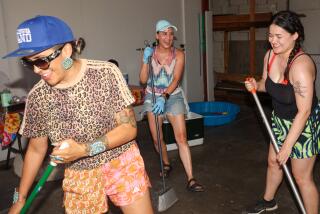High Life / A WEEKLY FORUM FOR HIGH SCHOOL STUDENTS : She’s Sticking Close to Her Roots : Culture: Antoinette Begay is only 14 but already understands the importance of her American Indian heritage and its values.
- Share via
“If you’ve never been to a Powwow, you have to experience it before you make assumptions as to what it is.”
So says Antoinette Begay, a 14-year-old who knows all about assumptions. Begay, who will be a freshman at Capistrano Valley High School next week, is also a member of the Navajo and Apache Indian tribes.
“Indians do not bop their mouths (with cupped hands) and run around bonfires all day,” said Begay, noting that the media coverage of American Indians since the success of the motion picture “Dances With Wolves” has helped to debunk some of myths.
“(The movie) was really good, pretty realistic,” said Begay, adding that it was the best portrayal of Indians in a long time.
The Powwow is a gathering of Indian tribes from across the United States, Canada and Mexico. The most recent one--the 23rd annual--took place for three days earlier this month at the Orange County Fairgrounds.
The event, sponsored by the Southern California Indian Center in Garden Grove, brought people together from 100 tribes in a celebration of life and nature. On display and sale were such non-traditional arts as posters, airbrush paintings, feathered headbands and T-shirts, as well as traditional silver jewelry studded with turquoise and coral.
But the main event, which tended to bring everything else to a standstill, was the dance competition, where participants were judged on their knowledge of the dance routine, their performance and costumes.
Begay, who competed in the junior girls’ division, recalled the time she won first place as a child.
“I was just really proud because it meant a lot to me and my family--that all the hard work paid off,” said Begay, whose father is a Navajo and mother an Apache.
Ever since Begay can remember, she has understood the importance of being a part of her tribe. She remembers being carried on her mother’s back in the woven holder made especially for her, and says learning about her culture was not difficult because she grew up in it.
But Begay said hardly any of her friends even know she’s an Indian.
“They don’t really know what it means to be Indian. Unless you are part of a tribe, it’s hard to explain what it really means,” she said.
“(The tribe) brings people of the same culture and values together. It goes beyond the clothing and dancing. . . . You feel it inside.”
Feathers play a large part in Indian culture. Each feather, which is worn with pride throughout one’s life, is earned through dances or other ceremonies during childhood. Each feather is considered a great blessing and must be treated with the utmost respect.
Begay received her first feather at a very young age, but she knew its importance because her mother explained the seriousness and responsibility of having one.
Along with the feathers, dress is important. All the work on the clothing is hand-sewn and represents many hours of difficult work. The colors are usually very bright, and each outfit is accompanied by a shawl. The boots are made to match and contain much beadwork.
Begay’s costume for the Powwow consisted of a full-length dress of aqua with brightly colored ribbons, pants and boots.
Through public performances such as the Powwow, non-Indians can begin to better understand their culture. They are a people who are not interested in fancy cars and large houses but, rather, in personal fulfillment and the environment.
“The land doesn’t belong to anyone. It’s here for all of us to care for because we live here,” Begay said. “Just recently the white man has begun to care for the land, and we’ve known this for years.”
More to Read
Sign up for Essential California
The most important California stories and recommendations in your inbox every morning.
You may occasionally receive promotional content from the Los Angeles Times.










